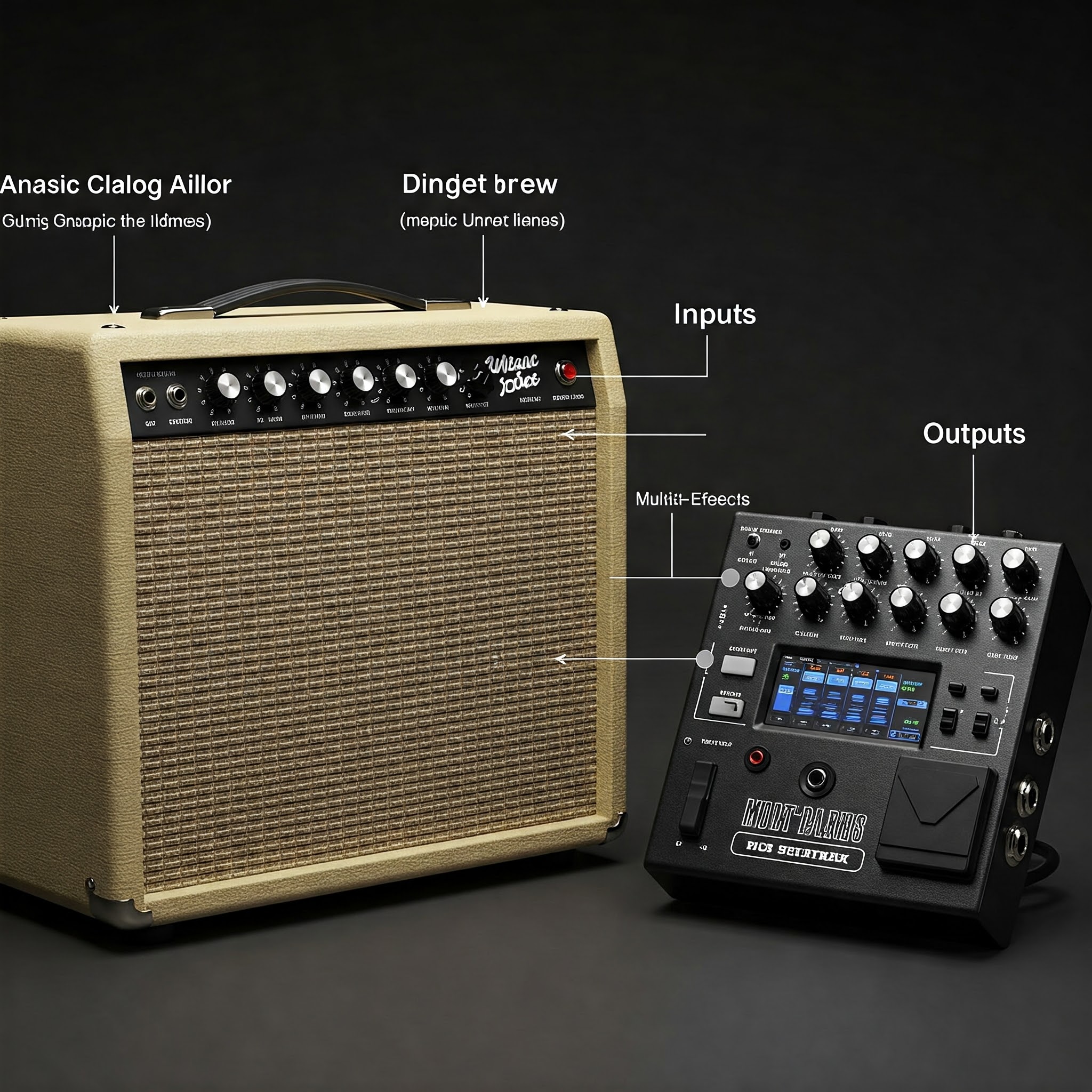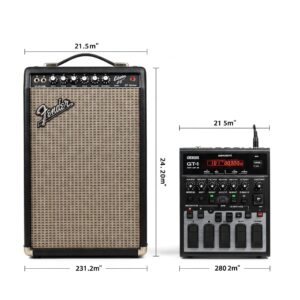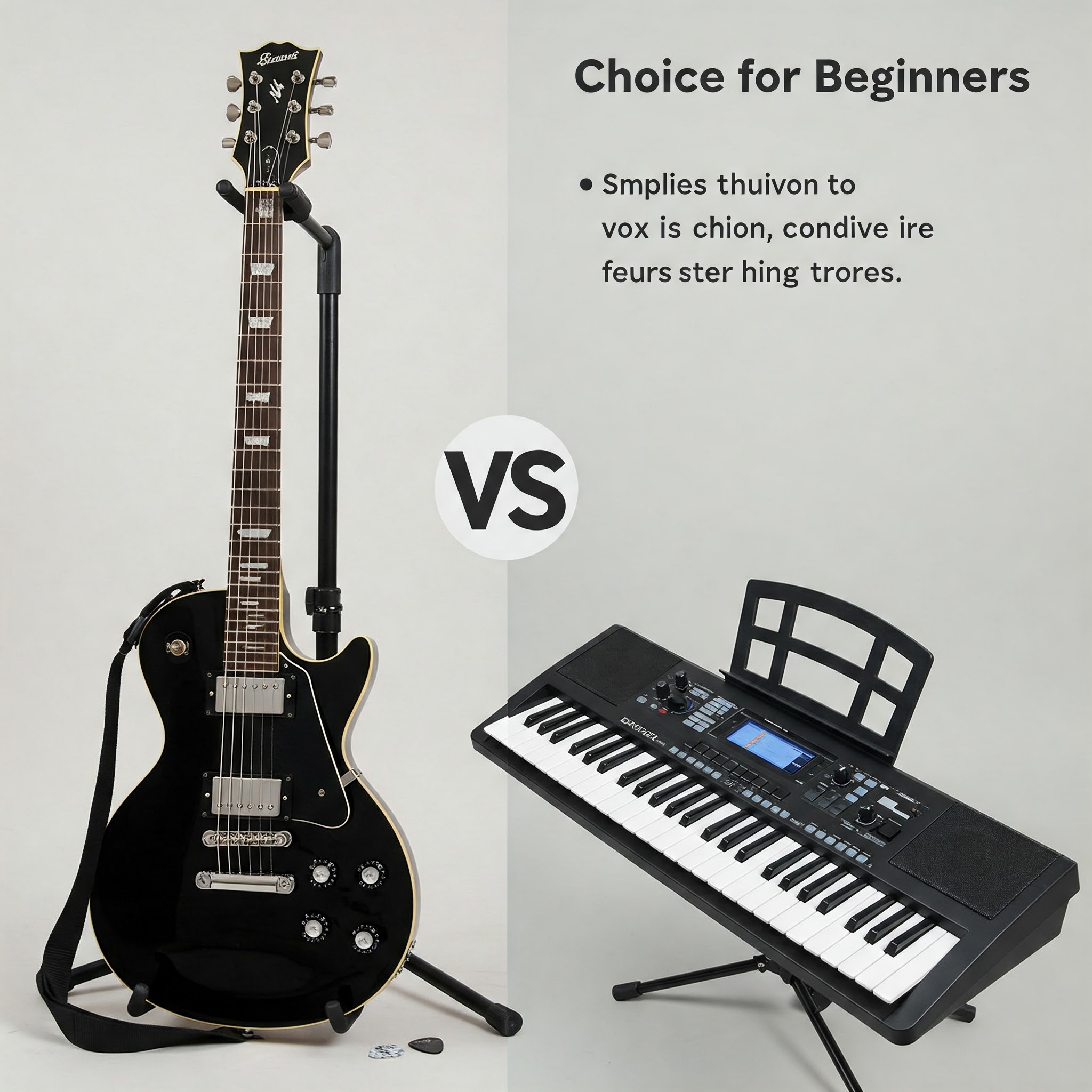The Eternal Tone Debate 
For guitarists everywhere, the quest for the perfect tone is nothing short of sacred. Whether you’re jamming in your bedroom, recording in a studio, or performing on stage, your sound defines your musical identity. Today, we’re diving deep into one of the most significant debates in the guitar world: guitar amp vs multi-effects pedal. This choice fundamentally impacts your sound, workflow, and even your approach to playing.
As a guitarist with over fifteen years of experience across various genres and performance settings, I’ve spent countless hours experimenting with both traditional amplifiers and cutting-edge digital effects. I understand the passion, confusion, and sometimes overwhelming options facing players today. The good news? There’s never been a better time to craft your signature sound, regardless of which path you choose.
In this comprehensive guide, we’ll explore the fundamental differences, pros and cons, and practical applications of both guitar amps and multi-effects pedals. By the end, you’ll have clarity on which option aligns best with your musical goals, playing style, and budget. So plug in, turn up, and let’s discover which approach will help you find your voice in the crowded landscape of guitar tones.
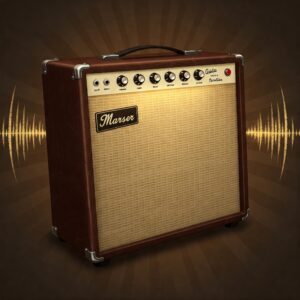
Understanding Guitar Amplifiers: The Traditional Approach 
What Exactly Is a Guitar Amplifier?
A guitar amplifier is more than just a device that makes your instrument louder. It’s an integral part of your tone creation, adding character, warmth, and personality to your guitar’s signal. Traditional guitar amps typically consist of two main components:


Guitar amplifiers come in several varieties, including tube (valve), solid-state, and hybrid designs, each offering distinct tonal characteristics.
The Magic of Tube Amplifiers
Tube amplifiers, beloved by countless professional guitarists, use vacuum tubes (or valves) to amplify your guitar signal. These technological relics from a bygone era remain popular because of their unique response and tonal qualities.
When pushed, tube amplifiers create natural compression and harmonic richness that’s extremely difficult to replicate digitally. This natural “breakup” is the secret behind countless classic guitar tones from artists like Jimi Hendrix and Eric Clapton.
According to a 2024 survey by Guitar Player Magazine, over 65% of professional guitarists still prefer tube amplifiers for live performances due to their responsive feel and dynamic range.
Solid-State and Modeling Amplifiers
Not all guitar amps rely on tubes. Solid-state amplifiers use transistors instead, often delivering:



Modern modeling amplifiers take things a step further by using digital technology to simulate the sound of classic amps. Brands like Kemper, Fractal, and Line 6 have pushed the boundaries of what’s possible, creating digital recreations so convincing that they’re increasingly used by touring professionals who need consistent tones night after night.
The Pros of Guitar Amplifiers
The enduring popularity of traditional guitar amplifiers isn’t without reason. Here are some compelling advantages:
- Authentic Tone and Feel: Many guitarists insist that nothing can replace the organic response and harmonic richness of a quality guitar amplifier, especially tube-based models.
- Simplicity and Immediacy: Most guitar amps feature straightforward controls that allow for intuitive tone shaping without diving through menus or presets.
- Physical Interaction: The physical interaction between your guitar, your playing dynamics, the amplifier, and the speaker creates a responsive experience that many players find essential to their expression.
- Room-Filling Sound: A guitar amp moves air in a way that creates a more immersive, three-dimensional sound experience compared to direct signals.
- Reliability: A quality guitar amp can last decades with proper maintenance, making it a long-term investment in your sound.
The Limitations of Guitar Amplifiers
Despite their tonal advantages, traditional guitar amps do come with certain drawbacks:






Exploring Multi-effects Pedals: The Digital Revolution 
What Are Multi-effects Pedals?
Multi-effects pedals are comprehensive digital devices that combine numerous guitar effects, amp simulations, and often recording capabilities into a single unit. These technological powerhouses have evolved dramatically over the past decade, closing the gap between digital simulation and analog reality.
Modern multi-effects units can contain:





The Evolution of Digital Modeling
The technology behind multi-effects pedals has made tremendous strides. Today’s premium units from manufacturers like Neural DSP, Line 6, and Boss utilize sophisticated algorithms and powerful processors to achieve unprecedented realism.
According to research by Berklee College of Music, the gap between analog and digital guitar tones has narrowed significantly, with many listeners unable to distinguish between high-quality digital models and their physical counterparts in blind tests.
The Pros of Multi-effects Pedals
Multi-effects pedals offer numerous advantages that have made them increasingly popular among guitarists at all levels:
- Versatility and Variety: Access to hundreds of effects and amp models in a single device allows for endless tonal exploration.
- Convenience and Portability: Most multi-effects units are compact and lightweight, making them ideal for traveling musicians.
- Consistency Across Venues: Direct connection to PA systems or audio interfaces ensures your tone remains consistent regardless of the acoustic environment.
- Preset Capabilities: The ability to save and recall complex signal chains with a single foot press is invaluable during live performances.
- Cost-Effectiveness: While premium units can be expensive, they typically offer better value than purchasing equivalent individual pedals and amplifiers.
- Silent Practice Options: Headphone outputs make silent practice possible at any hour.
- Recording Integration: USB connectivity and audio interface functionality streamline the recording process.
The Limitations of Multi-effects Pedals
Despite their impressive capabilities, multi-effects pedals aren’t without drawbacks:





Direct Comparison: Guitar Amp vs Multi-effects Pedal 
To help you visualize the key differences, let’s directly compare these two approaches across several important categories:
| Feature | Guitar Amplifiers | Multi-effects Pedals |
|---|---|---|
| Tone Quality | Organic, room-filling sound with natural harmonics | Increasingly realistic simulations with consistent results |
| Portability | Often heavy and bulky, especially tube amps | Compact and lightweight, ideal for traveling |
| Versatility | Limited to the amp’s inherent sound (unless paired with pedals) | Hundreds of effects and amp models in one unit |
| Ease of Use | Straightforward controls but limited preset options | More complex interface but comprehensive preset management |
| Volume Control | Can be challenging to achieve good tone at low volumes | Consistent tone at any volume, including headphones |
| Durability | Typically very durable but tubes require replacement | Generally reliable but potentially shorter lifespan |
| Cost | Higher initial investment for quality models | Better value in terms of sounds-per-dollar |
| Recording | Requires microphones and acoustic space | Direct recording with cabinet simulation |
Boss GT-1000CORE Multi-effects Processor
When it comes to premium multi-effects pedals that deliver exceptional versatility without overwhelming complexity, the Boss GT-1000CORE stands as a remarkable achievement. This compact powerhouse packs the same AIRD (Augmented Impulse Response Dynamics) technology as its larger sibling but in a pedalboard-friendly format.
Fender ’65 Twin Reverb Tube Amplifier
For guitarists seeking the quintessential tube amplifier experience, the Fender ’65 Twin Reverb remains an industry standard. This 85-watt classic recreates one of the most beloved amplifiers in history, delivering pristine cleans and responsive dynamics that have graced countless recordings.
Making Your Decision: Which Is Right For You? 
Consider Your Playing Environment
One of the most important factors in choosing between a guitar amp vs multi-effects pedal is where you’ll be playing most often.
If you primarily play at home, especially in an apartment or shared living space, a multi-effects pedal offers significant advantages. The ability to practice with headphones means you can work on your tone at any hour without disturbing others. Furthermore, the direct recording capabilities make home recording sessions much more straightforward.
Conversely, if you regularly perform in venues without sophisticated PA systems, a traditional guitar amplifier might be more practical. The ability to project sound independently can be crucial in smaller venues where monitor mixes might be limited.
Think About Your Musical Flexibility Needs
Your required tonal palette should heavily influence your decision between a guitar amp vs multi-effects pedal.
If you play in a cover band that tackles diverse material—perhaps jumping from clean country tones to high-gain metal within a single set—a multi-effects unit offers unmatched versatility. The ability to instantly recall completely different rigs with a single footswitch press can be invaluable in such scenarios.
On the other hand, if you’ve developed a signature sound that relies primarily on a specific amplifier’s character—perhaps with just a few core effects—a quality guitar amp paired with select individual pedals might better serve your needs.
Budget Considerations
While premium options exist in both categories, your budget might steer you toward one solution or the other.
A professional-grade tube amplifier can easily cost $1,500-$2,500, and that’s before adding any effects pedals. Conversely, even top-tier multi-effects units like the HeadRush Pedalboard or Line 6 Helix Floor typically fall within the $1,000-$1,800 range while providing hundreds of effects and amp models.
For beginners or players on tight budgets, affordable multi-effects units like the Zoom G3Xn offer tremendous value, providing dozens of effects and amp models for under $300.
Hybrid Setups: The Best of Both Worlds 
It’s important to note that the choice between a guitar amp vs multi-effects pedal isn’t necessarily binary. Many professional guitarists employ hybrid setups that leverage the strengths of both approaches.
The “Four-Cable Method”
One popular hybrid approach is the four-cable method, which integrates a multi-effects unit with a traditional amplifier. This setup allows you to:



FRFR + Modeling
Another hybrid approach involves pairing a multi-effects unit with an FRFR (Full Range Flat Response) speaker or powered monitor. This configuration:



According to a 2024 survey by Premier Guitar, approximately 45% of touring professional guitarists now use some form of hybrid setup, combining digital and analog technologies to achieve their ideal balance of versatility and tone.
Line 6 Helix Floor Multi-effects Processor
If budget allows and you’re seeking the absolute pinnacle of multi-effects processing, the Line 6 Helix Floor represents perhaps the most comprehensive solution available today. This flagship unit has become an industry standard for professionals seeking maximum flexibility without compromising sound quality.
→ Elevate Your Guitar Tone Today! 
 Ready to transform your guitar sound? The products mentioned above represent the cutting edge in both traditional amplification and digital processing. Click on any highlighted item to check current pricing and availability on Amazon. Whether you choose the organic warmth of a tube amp or the versatility of a multi-effects unit, these premium options will help you achieve professional-quality tone!
Ready to transform your guitar sound? The products mentioned above represent the cutting edge in both traditional amplification and digital processing. Click on any highlighted item to check current pricing and availability on Amazon. Whether you choose the organic warmth of a tube amp or the versatility of a multi-effects unit, these premium options will help you achieve professional-quality tone! 
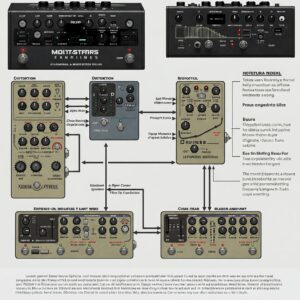
Practical Application: Genre-Specific Considerations 
Different musical styles often favor particular approaches to tone creation. Let’s explore how the guitar amp vs multi-effects pedal choice might be influenced by your preferred genres.
Rock and Blues
Traditional rock and blues tones often benefit from the organic overdrive and dynamic response of a tube amplifier. The natural compression and harmonic richness that occur when pushing tubes create that soulful quality that defines these genres.
However, many modern multi-effects units excel at recreating classic rock and blues tones. Units like the Neural DSP Quad Cortex feature remarkably accurate models of vintage amplifiers that have shaped these genres.
Metal and Heavy Music
Metal guitarists typically require high-gain tones with exceptional clarity and tightness. While dedicated high-gain amplifiers from manufacturers like Mesa/Boogie and EVH certainly deliver in this category, modern multi-effects units often provide advantages for metal players:



Research from Guitar World suggests that metal guitarists are among the fastest-growing user groups for premium modeling technology.
Ambient and Experimental
For ambient and experimental guitarists who rely heavily on expansive effect chains, multi-effects pedals offer clear advantages:



Jazz and Clean Tones
Jazz guitarists traditionally favor the warm, clean tones of hollow-body guitars through tube amplifiers. While this remains a popular approach, modern modeling has made significant strides in recreating these sophisticated clean tones.
The Boss Katana series, for instance, offers remarkably articulate clean sounds that many jazz players find compelling, especially when paired with appropriate cabinet simulation.
Recording Considerations 
For many guitarists, recording capability is a critical factor when choosing between a guitar amp vs multi-effects pedal.
Amplifier Recording Challenges
Recording a guitar amplifier traditionally involves:




However, the organic sound captured by this method remains the gold standard for many producers and engineers. According to a study by the Audio Engineering Society, properly recorded tube amplifiers exhibit transient response characteristics that contribute to perceived authenticity.
Multi-effects Recording Advantages
Multi-effects pedals offer numerous recording advantages:




Many professional studios now maintain both traditional amplifier setups and high-end modeling systems to accommodate different recording needs and artist preferences.
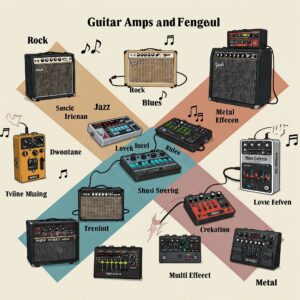
Practical Maintenance: Long-Term Ownership 
When considering the guitar amp vs multi-effects pedal question, maintenance requirements should factor into your decision.
Amplifier Maintenance
Traditional guitar amplifiers, especially tube models, require regular maintenance:




However, a well-maintained tube amplifier can last decades, with many vintage models from the 1960s and 1970s still performing beautifully today.
Multi-effects Maintenance
Digital multi-effects units generally require less maintenance:



The tradeoff is that digital equipment eventually becomes obsolete as technology advances, whereas classic amplifier designs remain relevant indefinitely.
Future-Proofing Your Investment 
Technology evolves rapidly, making future-proofing considerations important in the guitar amp vs multi-effects pedal debate.
Amplifiers as Long-Term Investments
Quality guitar amplifiers often retain their value remarkably well. According to Reverb.com‘s price guide data, many vintage amplifiers have appreciated significantly in value over the decades. Even modern boutique amplifiers tend to hold their value better than digital equipment.
The timeless design and sound of classic amplifiers ensure they remain relevant regardless of technological trends.
Multi-effects Evolution
Digital multi-effects pedals, while offering cutting-edge features, typically follow a more traditional technology depreciation curve:



However, manufacturers increasingly offer firmware updates that add significant features to existing hardware, extending the useful life of premium units.
→ Find Your Perfect Tone Match! 
 Whether you’re team tube amp or team digital modeling, the products featured in this article represent the best options in their respective categories. Click through to Amazon to explore detailed specifications, user reviews, and current pricing. Your ideal guitar tone is just a click away!
Whether you’re team tube amp or team digital modeling, the products featured in this article represent the best options in their respective categories. Click through to Amazon to explore detailed specifications, user reviews, and current pricing. Your ideal guitar tone is just a click away! 
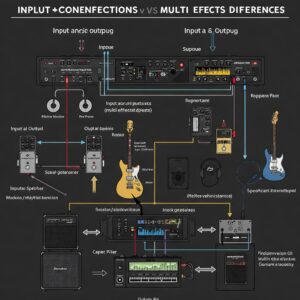
Community and Resale Considerations 
The guitar community’s perspective on the guitar amp vs multi-effects pedal debate continues to evolve, with implications for both user experience and resale value.
Community Support
Both traditional amplifiers and digital modeling systems benefit from strong community support, though in different ways:
- Amplifier communities often focus on modifications, tube-rolling, and other physical customizations
- Digital modeling communities frequently share presets, settings, and firmware update information
Platforms like The Gear Page host active discussions for both approaches, providing valuable resources regardless of which path you choose.
Resale Market Dynamics
The resale markets for these technologies differ significantly:




This difference should be considered if you anticipate upgrading or changing your setup within a few years.
Professional Perspectives: What The Pros Use 
To provide additional context for the guitar amp vs multi-effects pedal debate, let’s examine what professional guitarists are using on major tours and recordings.
The Touring Reality
According to a 2024 survey of touring guitarists published in Sound on Sound magazine:
- Approximately 35% use traditional amplifier setups exclusively
- Around 40% use digital modeling systems exclusively
- The remaining 25% employ hybrid setups combining both approaches
This distribution represents a significant shift from just a decade ago, when amplifiers dominated professional touring rigs.
Genre Variations
The survey revealed interesting genre-specific trends:
- Rock, blues, and country artists still favor traditional amplifiers (65%)
- Pop, R&B, and electronic-influenced genres predominantly use digital systems (72%)
- Metal and progressive genres show the highest adoption of hybrid setups (41%)
Studio Flexibility
In studio settings, flexibility remains paramount. According to Mix Magazine, over 80% of commercial recording studios now maintain both amplifier collections and premium modeling systems to accommodate artist preferences and specific tonal needs.
Kemper Profiler Stage Multi-effects Processor
For guitarists who want to capture and recreate the exact sound of specific amplifiers, the Kemper Profiler Stage represents a revolutionary approach. This innovative unit uses “profiling” technology to create incredibly accurate digital copies of physical amplifiers.
Conclusion: Finding Your Personal Solution 
After thoroughly exploring the guitar amp vs multi-effects pedal debate, the most important takeaway is that there’s no universally “correct” choice. The best solution depends entirely on your specific musical needs, practical constraints, and personal preferences.
Traditional guitar amplifiers continue to offer unmatched organic character and simplicity. Their intuitive operation and room-filling sound create an immersive playing experience that many guitarists find essential to their creative process. For players who have developed a signature sound around a specific amplifier, this approach remains compelling.
Multi-effects pedals provide unprecedented versatility and convenience. The ability to access hundreds of effects and amp models in a portable package—often at a fraction of the cost of equivalent physical gear—makes them increasingly popular across all player levels. Their silent practice options and recording integration are particularly valuable in modern playing environments.
Many guitarists find that hybrid setups offer the ideal balance, combining the organic feel of amplifiers with the flexibility of digital processing. As technology continues to evolve, the distinction between these approaches will likely continue to blur.
Ultimately, the most important consideration is which approach inspires you to play more and express yourself more effectively. Whether you choose a classic tube amplifier, a cutting-edge multi-effects processor, or some combination of both, the right gear is whatever helps you create the music you hear in your head.
→ Take Your Guitar Journey to New Heights! 
 Ready to make your decision? The products featured in this article represent the best options available for both guitar amps and multi-effects pedals. Click through to check current pricing and availability on Amazon. Whether you choose the warmth of tubes or the versatility of digital, these premium options will help you sound your best!
Ready to make your decision? The products featured in this article represent the best options available for both guitar amps and multi-effects pedals. Click through to check current pricing and availability on Amazon. Whether you choose the warmth of tubes or the versatility of digital, these premium options will help you sound your best! 
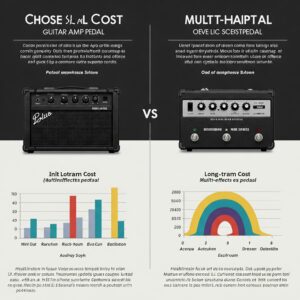
More FAQs
 Which is better for beginners: a guitar amp or a multi-effects pedal?
Which is better for beginners: a guitar amp or a multi-effects pedal?

 Do multi-effects pedals replace the need for a guitar amp?
Do multi-effects pedals replace the need for a guitar amp?

 Is sound quality better from a dedicated guitar amp or a multi-effects unit?
Is sound quality better from a dedicated guitar amp or a multi-effects unit?

 Can I use a multi-effects pedal with a guitar amp?
Can I use a multi-effects pedal with a guitar amp?

 What’s more portable: a multi-effects pedal or a combo amp?
What’s more portable: a multi-effects pedal or a combo amp?

Recommended for You:
- Single Coil vs Humbucker Pickups: The Ultimate Comparison Guide for 2025 – Pros, Cons & Pro Tips
- Solid body vs Hollow body electric guitar: The Ultimate Comparison Guide (2025)
- Dreadnought vs Concert Guitar: 7 Must-Know Differences for Inspired Players in 2025
Disclaimer: This article contains affiliate links. If you purchase products through these links, we may earn a small commission at no additional cost to you.

